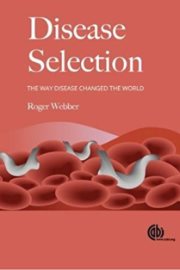Disease Selection: The Way Disease Changed the World
 Roger Webber
Roger Webber
CABI, £12.99
From an individual standpoint, infection with a communicable disease is more or less a chance happening. If considered at a population level, however, patterns of emergence and transmission of disease become apparent, and the effect of these on the development of societies may be appreciated.
This enjoyable book provides an insightful primer on which diseases have made the most impact on human history, how this happened and what the consequences were.
Twenty chapters cover infectious diseases of viral, bacterial, protozoal and helminth origin, as well as a few non-communicable conditions including cancer. The book starts by speculating on prehistoric life forms and their diseases, and ends by considering what the future holds for the interplay between humans and microorganisms.
In between, an informal, informative narrative explores the host-pathogen relationship, transmission routes, evolution and epidemiology of infectious diseases through the ages – think bubonic plague, smallpox, cholera, malaria, hookworm, tuberculosis, influenza and HIV/AIDS and you get the picture.
Even diseases carried by our pets merit a mention. I read this book on a long-haul flight and it engaged me enough to forego the usual in-flight entertainment.
As an infectious disease immunologist, this proved something of a busman's holiday. However, I learned plenty from the author, a retired public health physician with extensive experience of developing countries, who occasionally embellishes the book with anecdotes about his career. Biologists from all backgrounds would find this a worthwhile read.
Professor Andrew Taylor-Robinson CBiol FRSB


